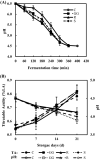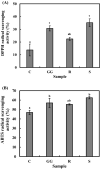Effect of set-type yoghurt supplemented with the novel probiotic Lantiplantibacillus plantarum 200655 on physicochemical properties and the modulation of oxidative stress-induced damage
- PMID: 36778087
- PMCID: PMC9905316
- DOI: 10.1007/s10068-022-01201-0
Effect of set-type yoghurt supplemented with the novel probiotic Lantiplantibacillus plantarum 200655 on physicochemical properties and the modulation of oxidative stress-induced damage
Abstract
The present study developed a functional yoghurt supplemented with Lantiplantibacillus plantarum 200655 and evaluated its physicochemical properties and antioxidant activities. Yoghurt samples were prepared using commercial starter cultures and probiotics and grouped as follows: control sample without probiotics (C), GG (supplemented with Lacticaseibacillus rhamnosus GG), R (supplemented with L. plantarum KCTC 3108), and S (supplemented with L. plantarum 200655). The GG, R, and S samples had shorter fermentation time compared with the C sample. Lactic acid bacteria count, pH, and titratable acidity were similar in all samples during refrigerated storage. However, the GG, R, and S samples showed increased viscosity and water holding capacity (WHC), and decreased syneresis. The S sample had no adverse effect on organoleptic properties. Furthermore, the S sample had the highest antioxidant activity and significantly inhibited LPS-induced oxidative stress in intestinal cells. These findings suggest the potential use of L. plantarum 200655 in dairy products with therapeutic benefits.
Keywords: Antioxidant activity; Functional food; Probiotics; ROS activity; Yoghurt.
© The Korean Society of Food Science and Technology 2022, Springer Nature or its licensor (e.g. a society or other partner) holds exclusive rights to this article under a publishing agreement with the author(s) or other rightsholder(s); author self-archiving of the accepted manuscript version of this article is solely governed by the terms of such publishing agreement and applicable law.
Conflict of interest statement
Conflict of interestThe authors affirm that they have no conflict of interest.
Figures



Similar articles
-
Bioprotection Potential of Lacticaseibacillus rhamnosus LRH01 and Lactiplantibacillus plantarum LP01 against Spoilage-Associated Penicillium Strains in Yoghurt.Molecules. 2023 Nov 2;28(21):7397. doi: 10.3390/molecules28217397. Molecules. 2023. PMID: 37959814 Free PMC article.
-
Influence of Lactobacillus plantarum WCFS1 on post-acidification, metabolite formation and survival of starter bacteria in set-yoghurt.Food Microbiol. 2016 Oct;59:14-22. doi: 10.1016/j.fm.2016.04.008. Epub 2016 Apr 28. Food Microbiol. 2016. PMID: 27375240
-
Characteristics of probiotic yoghurts supplemented with Pu-erh tea infusion.Acta Sci Pol Technol Aliment. 2019 Apr-Jun;18(2):153-161. doi: 10.17306/J.AFS.0640. Acta Sci Pol Technol Aliment. 2019. PMID: 31256543
-
Antioxidant and Angiotensin-Converting Enzyme (ACE) Inhibitory Activities of Yogurt Supplemented with Lactiplantibacillus plantarum NK181 and Lactobacillus delbrueckii KU200171 and Sensory Evaluation.Foods. 2021 Sep 30;10(10):2324. doi: 10.3390/foods10102324. Foods. 2021. PMID: 34681373 Free PMC article.
-
A novel approach to Lactiplantibacillus plantarum: From probiotic properties to the omics insights.Microbiol Res. 2023 Mar;268:127289. doi: 10.1016/j.micres.2022.127289. Epub 2022 Dec 22. Microbiol Res. 2023. PMID: 36571922 Review.
Cited by
-
Screening of Lactobacillus plantarum LPH10 and Its Anti-inflammatory Properties: Acid and Bile Salt Tolerance, Bacteriostatic Activity and Regulation of NF-κB/IRF Pathways.Probiotics Antimicrob Proteins. 2025 Aug 20. doi: 10.1007/s12602-025-10725-w. Online ahead of print. Probiotics Antimicrob Proteins. 2025. PMID: 40833721
-
Heat-Killed Lactilactobacillus sakei WB2305 and Lactiplantibacillus plantarum WB2324 Inhibited LPS-Induced Inflammation in Human Airway Epithelial Cells.Probiotics Antimicrob Proteins. 2024 Apr 9. doi: 10.1007/s12602-024-10251-1. Online ahead of print. Probiotics Antimicrob Proteins. 2024. PMID: 38592556
-
Lactiplantibacillus plantarum LM1001 Improves Digestibility of Branched-Chain Amino Acids in Whey Proteins and Promotes Myogenesis in C2C12 Myotubes.Food Sci Anim Resour. 2024 Jul;44(4):951-965. doi: 10.5851/kosfa.2024.e38. Epub 2024 Jul 1. Food Sci Anim Resour. 2024. PMID: 38974720 Free PMC article.
-
KL-Biome (Postbiotic Formulation of Lactiplantibacillus plantarum KM2) Improves Dexamethasone-Induced Muscle Atrophy in Mice.Int J Mol Sci. 2024 Jul 8;25(13):7499. doi: 10.3390/ijms25137499. Int J Mol Sci. 2024. PMID: 39000606 Free PMC article.
-
Anti-Inflammatory Effects of Paraprobiotic Lactiplantibacillus plantarum KU15122 in LPS-Induced RAW 264.7 Cells.J Microbiol Biotechnol. 2024 Jul 28;34(7):1491-1500. doi: 10.4014/jmb.2404.04052. Epub 2024 Jun 3. J Microbiol Biotechnol. 2024. PMID: 38960876 Free PMC article.
References
-
- Buldo P, Benfeldt C, Folkenberg DM, Jensen HB, Amigo JM, Sieuwerts S, Thygesen K, van den Berg F, Ipsen R. The role of exopolysaccharide-producing cultures and whey protein ingredients in yoghurt. LWT - Food Science and Technology. 2016;72:189–198. doi: 10.1016/j.lwt.2016.04.050. - DOI
-
- Choi J, Sabikhi L, Hassan A, Anand S. Bioactive peptides in dairy products. International Journal of Dairy Technology. 2012;65:1–12. doi: 10.1111/j.1471-0307.2011.00725.x. - DOI
-
- Donkor ON, Nilmini SLI, Stolic P, Vasiljevic T, Shah NP. Survival and activity of selected probiotic organisms in set-type yoghurt during cold storage. International Dairy Journal. 2007;17:657–665. doi: 10.1016/j.idairyj.2006.08.006. - DOI
LinkOut - more resources
Full Text Sources
Molecular Biology Databases
